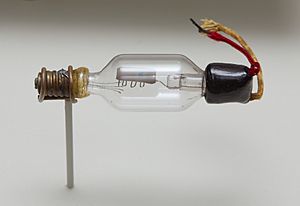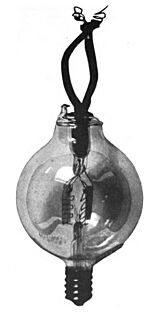Audion facts for kids

The Audion was an important electronic device invented by American engineer Lee de Forest in 1906. It was a special kind of vacuum tube that could make weak electrical signals stronger, which is called amplifying. Imagine a tiny whisper becoming a loud voice – that's what the Audion did for electrical signals!
It started as a simple two-part tube, but by 1908, it became the first "triode" (meaning three parts). These three parts were a heated wire (called a filament), a grid, and a plate. The Audion was a huge step forward in technology because it was the first widely used electronic device that could amplify signals. This meant a small signal put into the grid could control a much bigger signal coming out of the plate.
Early Audions had some gas inside, which made them a bit tricky and not always work perfectly. They were first used to detect radio signals. Around 1912, people realized they could also amplify signals. This discovery led to the first amplifying radio receivers and electronic oscillators. Because amplification was so useful, the Audion quickly improved. Newer versions with a better vacuum soon replaced the original design.
Contents
How the Audion Changed Radio

For a long time, people knew that gas could conduct electricity. Early radio experimenters noticed that radio waves affected this. De Forest found that gas in a partial vacuum (like a very empty space) heated by a lamp filament acted similarly. He discovered that if he wrapped a wire around the glass tube, the device could detect radio signals.
In his first design, a small metal plate was sealed inside the lamp. This plate connected to a battery and headphones. When radio signals hit the wire wrapped around the tube, they changed the electric current. This made sounds in the headphones.
This was a big deal because other radio systems were protected by patents. A new type of detector would let de Forest sell his own system. He later found that adding a third part, called a "grid," inside the tube made it much more sensitive. This grid was just a bent piece of wire.
The Audion could make signals stronger. Before the Audion, all the power for the headphones had to come from the antenna itself. This meant weak radio signals were very hard to hear. With the Audion, even weak signals could be heard from far away.
Patents and New Ideas
De Forest received a patent for his two-part Audion in 1906. The three-part "triode" version was patented in 1908. De Forest often said he didn't know exactly why his invention worked, just that it did. He also had many arguments about who invented what in radio.
In 1914, a student named Edwin Howard Armstrong studied the Audion. He explained how it worked using diagrams and graphs. Armstrong showed that de Forest still didn't fully understand his own invention.
The problem was that de Forest's original patents said that a small amount of gas inside the Audion was needed for it to work. This gas made early Audions unreliable. Sometimes they worked great, other times not at all.
Many researchers tried to make the Audion more reliable. Irving Langmuir at General Electric (GE) labs did a lot of work on this.
Kenotron and Pliotron

Langmuir believed that some problems with vacuum devices were due to dirt, not basic physics. He found that if he made a vacuum tube extremely clean, it worked much better. He created a device called the "Kenotron," which was a very clean, empty (vacuum) tube used to change alternating current into direct current.
He then applied this idea to the Audion. Instead of trying to keep a little gas inside, he wondered if it could work with a complete vacuum, like his Kenotron. He found that his "vacuum" Audion worked very differently. It could amplify signals much more clearly and at higher speeds. He called his new device the "Pliotron," meaning "more" or "gain," because it made the signal much stronger.
The terms "Kenotron" and "Pliotron" were trademarks. So, people started using the more general term "vacuum tube." By the 1920s, "Kenotron" usually meant a vacuum tube that changed current, and "Pliotron" was no longer commonly used.
How Audions Were Used
Before the Audion, radio receivers used different detectors like crystals and wires. These were often unreliable and needed constant adjusting. They also didn't make the signal any stronger. Users had to listen through headphones, sometimes at very low volume, because the only power came from the antenna. For long-distance communication, huge antennas and powerful transmitters were needed.
The Audion was a big improvement. While the first Audions didn't amplify the signal after detection, later vacuum triodes could make the signal as strong as needed. You could connect one triode's output to the next, making the signal powerful enough to drive a full-sized speaker. They could also amplify incoming radio signals *before* detection, making the whole process much more efficient.
Vacuum tubes also helped create better radio transmitters. The combination of stronger transmitters and more sensitive receivers changed radio communication during World War I.
By the late 1920s, "tube radios" became common in homes. They stayed popular until transistor radios came out in the mid-1950s. Today, transistors have mostly replaced vacuum tubes. However, vacuum tubes are still used in powerful transmitters, guitar amplifiers, and some high-quality audio equipment.
Images for kids
-
The first Audion AM radio transmitter, built by Lee de Forest in 1914.
-
Some of the earliest Audion AM radio transmitters, built by de Forest around 1916.
See Also







